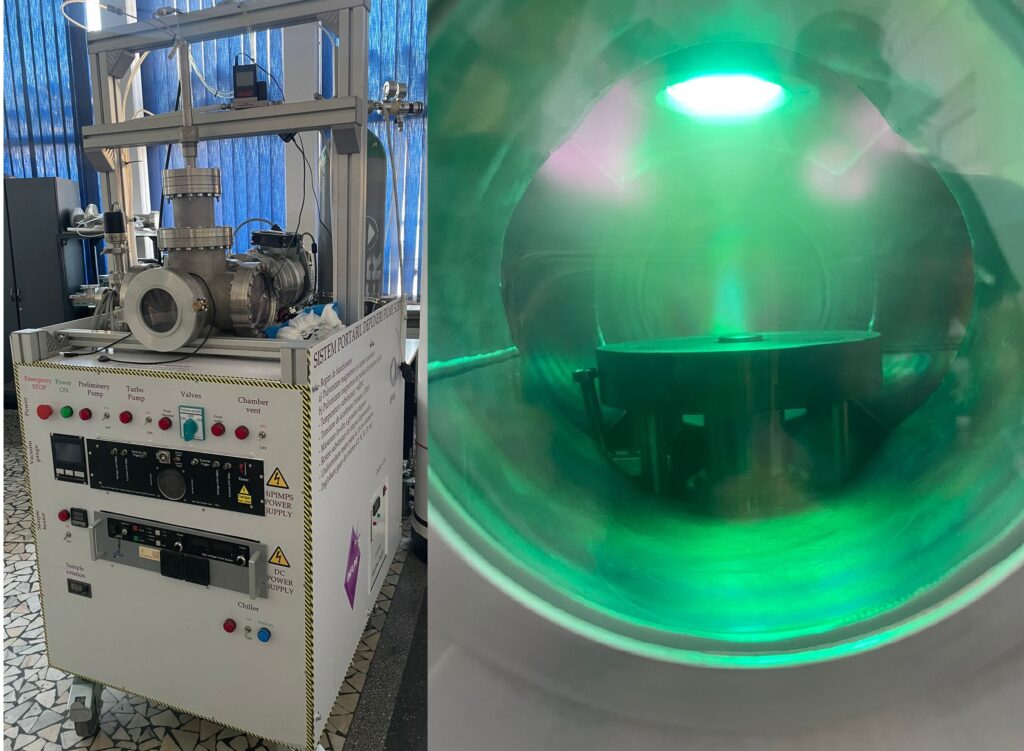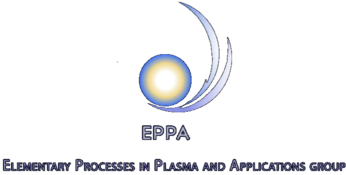Thermionic Vacuum Arc installations
Used to develop coatings with tribological, anticorrosive and antibacterial properties. The installation is provided with three anode-cathode systems for coating large surfaces, an oven that can raise the temperature of the deposited samples up to 400 oC, rotation of the samples during deposition to ensure a high degree of uniformity, possibility of cleaning the samples in-situ by Glow Discharge in the Ar atmosphere, the possibility of measuring the deposition rates in-situ by means of quartz microbalances in order to ensure a well-defined stoichiometry of the deposited layers, the possibility of applying additional voltage (Bias) to accelerate the ions on samples.Work pressure: 10-6 – 10-4 mbarBIAS: max 1000 V Substrate dimensions: 100x200x18 mm3, 4×1 inchsi 2×2 inch Cooling system: Water-cooledChamber Volume:: 0.7 m3

Thermionic Vacuum Arc chamber Instalation (Be Area)
Used to develop coatings with tribological, anticorrosive and antibacterial properties. The installation is provided with three anode-cathode systems for coating large surfaces, an oven that can raise the temperature of the deposited samples up to 400 oC, rotation of the samples during deposition to ensure a high degree of uniformity, possibility of cleaning the samples in-situ by Glow Discharge in the Ar atmosphere, the possibility of measuring the deposition rates in-situ by means of quartz microbalances in order to ensure a well-defined stoichiometry of the deposited layers, the possibility of applying additional voltage (Bias) to accelerate the ions on samples.Work pressure: 10-6 – 10-4 mbarBIAS: max 1000 V Cooling system: Water-cooledChamber Volume:: 0.7 m3

Magnetron deposition Installations
Used to produce coatings with tribological, anticorrosive and antibacterial properties. The installation is provided with 5 magnetrons for uniform coatings on large surfaces.Adjustable temperature- Room Temperature- 400 oCSubstrate rotation: YesBias: max 150 V DCCalibrated Mass flow controllers. Up to five types of gas can be mixed

Experimental magnetron sputtering Installation
Used to produce Be and Be-based coatings with application in nuclear fusion Adjustable temperature- Room Temperature- 400 oCSubstrate rotation: NoBias: max 150 V DCCalibrated Mass flow controllers. Up to five types of gas can be mixedChamber volume: 0.05 m3

Portable Magnetron sputtering system
Operating parameters: DC, RF and HiPI magnetron sputtering; Subtsrate temperature up to 400 degrees C, maximum ion acceleration voltage: -700V; in-situ thickness monitor; substrate rotation; 10 cm diameter uniformity achieved; gaseous inclusions during the depositions availabel: (H, D, N, O, Ne, etc.)

Sectioning system for components exposed to fusion plasma
Low speed metal saw- Sectioning Be tiles at low temperatures (< 70oC)Thermal vision camera – FLIR E8Machining instrumentation for divertor tile sectioning
Plasma Treatment Setup
This system is designed to achieve high vacuum conditions – base-pressure: 10-6 mbar, ensuring of high purity treatments. The injection of diverse working gases such as N, O, H, Ar, Ne, among others is performed by independent mass flow controllers for each gas introduced in the reaction chamber and therefore, ensuring the adjustable gas mixtures compositions. To ignite and sustain the plasma, the planar diode electrode configuration with adjustable distances is powered by an off-the-shelf Pulsed Direct Current High Voltage Power Supply. The power supply offers a variable output voltage of up to 2000V, adjustable pulse duration ranging from 1 to 20µs, and a variable frequency from 500Hz to 100kHz. This remarkable versatility is instrumental in achieving the desired effects of the plasma treatment across a diverse array of materials. Using a robotic arm mounted inside the reaction chamber, it can manipulate the sample position and angle in respect to the plasma`s glow discharge (plasma main body), to ensure a uniform exposure across a wide range of geometries.

Tribometer– study of friction coefficient and wear rate of coatings Work environment: air, liquid Adjustable work speed: 2 cm/s

Thermal desorption Spectroscopy (TDS)- study of the release kinematics of gaseous species released from thin layers and surfacesQuadrupole Mass Spectrometer: Quadera QMG 220. Mase: 1-220 uamThermoresistant Quartz TubeOven: Termolite Gero RT-1050oCAdjustable heating ramp: Yes (0.1-15oC) Operating pressure: 10-9 mbar

